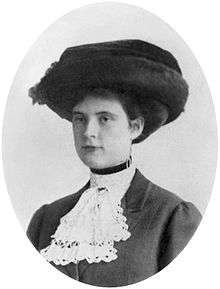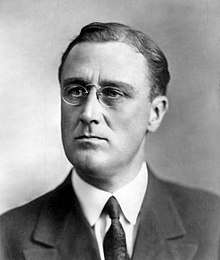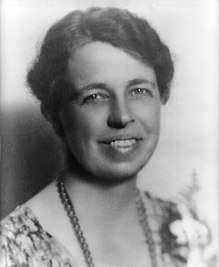Lucy Mercer Rutherfurd
Lucy Page Mercer Rutherfurd (April 26, 1891 – July 31, 1948) was an American woman who was best known for her affair with future US President Franklin D. Roosevelt.
Lucy Page Mercer Rutherfurd | |
|---|---|
 Lucy Page Mercer, circa 1915 | |
| Born | Lucy Page Mercer April 26, 1891 Washington, DC |
| Died | July 31, 1948 (aged 57) |
| Occupation | Dress store worker, secretary |
| Known for | Relationship with Franklin D. Roosevelt |
| Spouse(s) | |
| Children | Barbara Mercer Rutherfurd |
Background
Lucy Page Mercer was born on April 26th, 1891, in Washington, D.C., to Carroll Mercer, (1857–1917), a member of Theodore Roosevelt's "Rough Riders" cavalry military unit in the campaigns in Cuba, on the south shore of the island near Santiago during the brief Spanish–American War in 1898, and Minna Leigh (Minnie) Tunis, (1863–1947), an independent woman of "Bohemian" exotic, free-spirited tastes.[1] Lucy had one sister, Violetta Carroll Mercer (1889–1947).[2] Though they were both from wealthy, well-connected families, Mercer's parents lost their fortune through the Financial Panic of 1893 and subsequent great recession/depression which curtailed their lavish spending.[3] The pair separated shortly after Lucy's birth, and Carroll became an alcoholic. Minnie then raised the girls alone.[1]
Affair with Franklin D. Roosevelt


As a young woman, Lucy Mercer worked in a dress shop.[4] In 1914, Mercer was hired by Eleanor Roosevelt to become her social secretary. She quickly became an established part of the Roosevelt household, and good friends with Eleanor.[5] According to historians Joseph Persico and Hazel Rowley, the affair between Mercer and Franklin likely began in 1916, when Eleanor and the children were vacationing at Campobello Island to avoid the summer heat, while Franklin remained in Washington, D.C.[6][7] In 1917, Franklin often included Mercer in his summer yachting parties, which Eleanor usually declined to attend.[8]
In June 1917, Mercer quit or was fired from her job with Eleanor and enlisted in the US Navy, which was then mobilizing for World War I.[8][9] Franklin was at that time the Assistant Secretary of the Navy, and Mercer was assigned to his office.[8] Mercer and Franklin continued to see one another privately, causing widespread gossip in Washington. Alice Roosevelt Longworth—daughter of Theodore Roosevelt, and a cousin of Eleanor's—encouraged the affair, inviting Mercer and Franklin to dinner together several times. She later commented, "He deserved a good time. ... He was married to Eleanor."[10]
In 1918, Franklin went on a trip to Europe to inspect naval facilities for the war. When he returned in September, sick with pneumonia in both lungs, Eleanor discovered a packet of love letters from Mercer in his suitcase.[11] Eleanor subsequently offered her husband a divorce.[12]
Franklin's mother, Sara Delano Roosevelt, was adamantly against the idea of divorce, however, as it would mark the end of Franklin's political career, she stated that she would cut him off from the family fortune if he chose separation. Historians have also debated whether, as a Roman Catholic, Mercer would have been willing to marry a divorced man.[12] Eleanor Roosevelt biographer Blanche Wiesen Cook expressed skepticism that this had been a serious obstacle, noting the depth of Mercer's feelings.[13] Persico also doubts that this was a factor, observing that Mercer's mother Minnie had divorced and remarried, and that the family had come to Roman Catholicism only recently.[14]
In the end, Franklin appears to have told Mercer disingenuously that Eleanor was not willing to grant a divorce.[15] He and Eleanor remained married, and he pledged never to see Mercer again. The Roosevelts' son James later described the state of the marriage after the incident as "an armed truce that endured until the day he died".[16] Eleanor later wrote, "I have the memory of an elephant. I can forgive, but never forget."[17] The incident marked a turning point in her life; disillusioned with her marriage, she became active in public life, and focused increasingly on her social work rather than her role as a wife.[18][19]
Marriage and continued contact with Roosevelt
Mercer left Washington after the affair and became the governess for the children of Winthrop Rutherfurd, (1862–1944), a wealthy New York socialite.[20] Winthrop Rutherfurd was famous for winning the heart of socialite/heiress Consuelo Vanderbilt, (1877–1964), back in 1896, only to see her social-climbing mother instead force her into marriage with Charles Spencer-Churchill, 9th Duke of Marlborough, (1871–1934), (cousin to later British prime minister Winston Churchill). Now in his fifties, Rutherfurd was considered one of society's most eligible widowers. About a year and half later, on February 11, 1920, Mercer became his second wife.[21] Franklin Roosevelt learned of the marriage by overhearing news of it at a party.[22] The Rutherfurds had one child, Barbara Mercer Rutherfurd (June 14, 1922–November 6, 2005),[23][24] who married Robert Winthrop "Bobby" Knowles, Jr. in 1946.[25][26]
Despite Franklin's promise to Eleanor, he kept in contact with Lucy Rutherfurd after her marriage, corresponding with her by letter throughout the 1920s.[27] Historian/author Persico speculates that these letters may have been the cause of the 1927 nervous breakdown of Franklin's long-time unmarried first secretary Marguerite "Missy" LeHand, (1898–1944), as LeHand was also reputedly in love with Roosevelt and no medical cause for her breakdown was found.[28]
In 1926, Roosevelt mailed Rutherfurd a copy of his first public lecture after his 1921 paralytic illness, privately dedicating it to her with an inscription.[29] At his first memorable presidential inauguration on March 4, 1933, Roosevelt made arrangements for Rutherfurd to attend and witness his swearing-in.[30] When her husband later suffered a stroke, she contacted Roosevelt to arrange for him to be cared for at well-regarded Walter Reed Army Medical Center in Washington, D.C.[31] Historian/author Doris Kearns Goodwin speculated that an entry in the White House ushers diary for August 1, 1941 included a code name for Lucy Rutherfurd, suggesting that she attended a private dinner with the president then.[32] After her husband's death in 1944, when the two began seeing each other more occasionally, Rutherfurd also arranged for her friend Elizabeth Shoumatoff, (1888–1980), a well-known artist, to paint Roosevelt's portrait.[33]
Winthrop Rutherfurd died in March 1944 after a long illness.[34] Rutherfurd continued to meet more frequently with Roosevelt in the months that followed.[35] In June 1944, Franklin requested of his daughter Anna, who was then managing some White House social functions and acting as hostess, that she help him arrange to meet Rutherfurd without Eleanor's knowledge. Aware of Rutherfurd's role in her parents' early marriage, Anna was at first angry that her father had put her in such a difficult position. However, she ultimately relented and set up a meeting in Georgetown. To her surprise, Anna found that she liked Rutherfurd immediately, and the pair became friends. There were supposedly several dinners in the White House's second floor private quarters during Roosevelt's last year which were attended by Rutherfurd in a group with Anna's presence and obvious acceptance.[36] When Eleanor discovered, shortly after Franklin's death, from some female cousins, of Anna's role in arranging these meetings, the relationship between Eleanor and Anna became strained and cool for some time.[37]
In early April 1945, Anna arranged for Rutherfurd to come over from her South Carolina estate in Aiken to meet her father at his "Little White House" in Warm Springs, Georgia, the small plain rustic cottage built at the polio therapy center by the heated mineral water springs resort that Roosevelt helped develop beginning in the 1920s. Rutherfurd and Shoumatoff along with two female cousins were sitting there as the artist worked on her painting of Roosevelt as he sat at a card table by the living room stone fireplace, fine-tuning a future speech and reading over some other papers on the early afternoon of April 12, 1945. In this quiet domestic scene as the two had just been smiling at each other, Roosevelt suddenly placed his hand up on his forehead and temple, saying "I have a terrific headache", then slumped over losing consciousness. Later his two doctors - called in soon after the event - said he suffered a fatal cerebral hemorrhage. Since a thorough medical exam a year before, he had received increasingly more intensive care and concern from a young recently recruited private physician. [38] The two women, Mercer and Shoumatoff, immediately packed and left the cottage.[39] Eleanor nonetheless soon later learned the truth from the cousins and felt doubly betrayed to learn of her daughter's role in the long-time deception.[40][41] Finding Shoumatoff's unfinished preliminary watercolor among Franklin's possessions some time later however, she mailed it to Rutherfurd, to which Rutherfurd responded with a warm letter of thanks and condolences.[42]
In 1947, Rutherfurd's sister Violetta committed suicide after her husband requested a divorce, and only a month later on Christmas Day 1947, her mother Minnie died at age 84. [43] Just 7 months later, Rutherfurd herself died from leukemia at the young age of 57, on July 31, 1948, just 3-1/4 years after FDR, having destroyed almost all of her correspondence with Franklin.[44][45] Rutherfurd is buried along with her husband in Green Township, New Jersey.
Public revelation of affair
Following Roosevelt's death, his administration concealed from the press the fact that Rutherfurd had been present during his death, fearing the scandal that would ensue. Shoumatoff's presence became known, and she gave a press conference to address questions, but managed to hide Rutherfurd's role and was even not mentioned in early post-war biographies and administration histories for almost two decades.[46] Roosevelt's second private secretary Grace Tully, (1900–1984), who had also been at Warm Springs at the time of his death, did briefly mention Rutherfurd's presence in "F.D.R., My Boss", her 1949 memoir, but gave no further hint of the relationship. Though it was reported several times in Eleanor's lifetime that Roosevelt had had a serious affair with an unnamed Catholic woman, this remained only a rumor for decades.[47]
The Mercer–Roosevelt affair became wider public knowledge in 1966, when revealed in "The Time Between the Wars", a memoir of the decades 1920s and 1930s, written by Jonathan W. Daniels, (1902–1981), a former Roosevelt aide from 1943 to 1945.[42][48] When the news of the memoir's contents broke, Franklin Delano Roosevelt, Jr., (1914–1988), said that he had no knowledge of an affair between Rutherfurd and his father,[49] while Rutherfurd's daughter Barbara flatly denied that any such romance had occurred.[49] Well-known historian/author Arthur Schlesinger Jr., (1917–2007), stated of the affair that if Rutherfurd "in any way helped Franklin Roosevelt sustain the frightful burdens of leadership in the second world war, the nation has good reason to be grateful to her".[50]
Popular culture
Mercer's friendship with Franklin Roosevelt is portrayed in the well-regarded TV mini-series Eleanor and Franklin starring Edward Herrmann and Jane Alexander, with Mercer portrayed by actress Linda Kelsey from the 1976 telecast, (a second series was also subsequently broadcast in 1977 entitled Eleanor and Franklin: The White House Years with flash-backs to earlier episodes) and based on the earlier best-selling biography of the same name by Eleanor's personal friend Joseph P. Lash in 1971.
In addition, the relationship was covered in a documentary film in XX - FDR for "The Presidents" series of multi-part video retrospectives for the American Experience series on American history and biography on the Public Broadcasting Service (PBS), and in the 2014 documentary film, also televised for the Public Broadcasting Service (PBS), The Roosevelts, directed by noted documentary film-maker Ken Burns, with an accompanying companion pictorial book by Geoffrey Perrett.
References
- Rowley 2010, pp. 67–68.
- Persico 2008, p. 30.
- Persico 2008, pp. 30–31.
- Pearson, Drew (September 1, 1968). "Franklin Roosevelt Was Not Diplomatic as Wife". The Nevada Daily Mail. Retrieved January 28, 2013.
- Cook 1992, p. 217.
- Persico 2008, p. 93.
- Rowley 2010, p. 72.
- Rowley 2010, p. 75.
- Persico 2008, p. 98.
- Rowley 2010, p. 78.
- Rowley 2010, pp. 79–80.
- Cook 1992, p. 228.
- Cook 1992, pp. 228—29.
- Persico 2008, p. 128.
- Rowley 2010, p. 82.
- "FDR's Secret Love: How Roosevelt's lifelong affair might have changed the course of a century". U.S. News & World Report. April 18, 2008. Archived from the original on January 29, 2013. Retrieved January 28, 2013.
- Persico 2008, p. 130.
- Goodwin 1994, p. 20.
- McGrath, Charles (April 20, 2008). "No End of the Affair". The New York Times. Archived from the original on January 29, 2013. Retrieved January 28, 2013.
- Goodwin 1994, p. 376.
- Persico 2008, pp. 137–39.
- Cook 1992, p. 229.
- "Paid Notice: Deaths KNOWLES, BARBARA RUTHERFURD". The New York Times. 12 November 2005. Retrieved 18 July 2017.
- "Mrs. Barbara Knowles (AIKEN, S.C.)". The Augusta Chronicle. November 9, 2005. Archived from the original on January 29, 2013. Retrieved January 28, 2013.
- Korman, Murray (4 January 1946). "MISS RUTHERFURD BECOMES FIANCEE; BETROTHED | Member of Noted Family WIll Be Wed to Robert Winthrop Knowles, Jr. of Boston". The New York Times. Retrieved 18 July 2017.
- Times, Special To The New York (10 April 1946). "MISS RUTHERFURD MARRIED IN AIKEN; Fermata School Graduate the Bride of Robert W. Knowles Jr., Former Service Man". The New York Times. Retrieved 18 July 2017.
- "February 2011: FDR Letters to Lucy Mercer Rutherfurd". Franklin D. Roosevelt Presidential Library. Retrieved January 28, 2013.
- Persico 2008, p. 172.
- Persico 2008, p. 179.
- Persico 2008, p. 202.
- Goodwin 1994, p. 435.
- Goodwin 1994, p. 434.
- Goodwin 1994, p. 433.
- Goodwin 1994, p. 499.
- Goodwin 1994, p. 500.
- Goodwin 1994, pp. 517–19.
- http://www.gwu.edu/~erpapers/teachinger/glossary/halstead-anna.cfm
- Goodwin 1994, pp. 598, 600.
- Rowley 2010, p. 282.
- Rowley 2010, p. 284.
- Goodwin 1994, p. 614.
- Walker, Melissa (2001). "Rutherfurd, Lucy Mercer". In Maurine Hoffman Beasley; Holly Cowan Shulman; Henry R. Beasley (eds.). The Eleanor Roosevelt Encyclopedia. Greenwood Publishing Group. ISBN 978-0-313-30181-0.
- Persico 2008, pp. 354–55.
- Persico 2008, p. 351.
- Rowley 2010, p. 293.
- Rowley 2010, p. 291.
- Rowley 2010, p. 294.
- "New light on the revelations of Franklin Roosevelt's 30-year affection for Lucy Mercer Rutherfurd". Life. September 2, 1966. Archived from the original on May 7, 2017. Retrieved January 28, 2013.
- "Kin Deny Account of F.D.R. Romance," The New York Times, 13 August 1966,
- Persico 2008, p. 356.
Bibliography
- Cook, Blanche Wiesen (1992). Eleanor Roosevelt, Volume 1. Penguin. ISBN 0140094601.CS1 maint: ref=harv (link)
- Goodwin, Doris Kearns (1994). No Ordinary Time. Simon & Schuster. ISBN 9780684804484.CS1 maint: ref=harv (link)
- Persico, Joseph E. (2008). Franklin & Lucy: President Roosevelt, Mrs. Rutherfurd, and the Other Remarkable Women in His Life. Random House. ISBN 9781400064427.CS1 maint: ref=harv (link)
- Rowley, Hazel (2010). Franklin and Eleanor: An Extraordinary Marriage. Farrar, Straus and Giroux. ISBN 9780374158576.CS1 maint: ref=harv (link)
